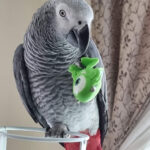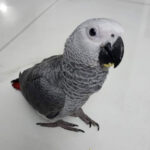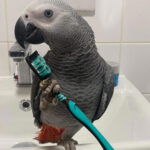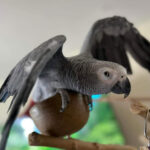- By chestergrey
- In Uncategorized
Common Viral Diseases of Pet Birds (African grey parrots)—-Avian Bornavirus / Proventricular Dilatation Disease
Avian bornavirus (ABV) is a neurotropic virus that causes proventricular dilatation disease (PDD). PDD is a progressive neurologic disease that uniquely affects the nervous system and is fatal once clinical signs develop. PDD, also known as macaw wasting disease, neuropathic ganglioneuritis, lymphoplasmacytic ganglioneuritis, psittacine encephalomyelitis, and avian ganglioneuritis, was first recognized in the late 1970s in macaws imported into the US and Germany. The disease primarily affects macaws, conures, and African grey parrots, although all parrots are considered susceptible. Avian bornavirus has been reclassified. The two species known to cause PDD in parrots are psittaciform bornavirus 1 and 2 and include parrot bornavirus (PaBV) genotypes 1–8. PaBV-2 and PaBV-4 are the most commonly reported genotypes in parrots.
The most common presentation of affected birds is chronic weight loss (often following an initial increase in appetite), passage of undigested food (most easily recognized when whole seeds are found in the droppings), and regurgitation. A dilated proventriculus may be seen radiographically. GI tract signs often reflect pathology of the terminal ganglia of the vagus nerve (cranial nerve X). Secondary bacterial or fungal infections of the nonmotile proventriculus can result in chronic infections and sepsis. Myocarditis related to avian bornavirus/PDD has been reported. Neurologic signs (convulsions, tremors, weakness, ataxia, blindness) may occur in some species, with or without concurrent GI signs. Avian bornavirus is shed in the urine as well as the feces, and some birds may experience polyuria. Clinical signs may be slowly progressive or develop acutely. Outbreaks are sporadic, with a low morbidity and a high mortality.
Transmission of Avian Bornavirus / Proventricular Dilatation Disease in Pet Birds
Avian bornavirus/PDD is contagious, but the actual mode of transmission is not clear. The spread of PaBV and PDD has been well documented, detailing how diseases spread after introduction of an adult bird with fatal PDD into an aviary. Because ABV can be detected in droppings (feces and urine), the fecal-oral route of transmission is considered the most likely, although a recent article investigating different infection routes of parrot bornavirus in cockatiels revealed that transmission of PaBV by oral or intranasal routes was unsuccessful. A second article indicated that transmission of PaBV by direct contact is inefficient in immunocompetent, fully fledged birds.
PaBV is widely distributed in captive and wild bird populations, and the infection is common among captive psittacines in North America and Europe. However, infection does not always cause PDD. Many healthy or subclinical carriers of several species have been documented. In studies in Europe and in North America, as many as 15%–40% of healthy parrots are positive for PaBV. Vertical transmission has not been proved but seems likely.
Diagnosis of Avian Bornavirus / Proventricular Dilatation Disease in Pet Birds
A presumptive diagnosis can be made based on history, clinical signs, and radiographic evaluation. Survey films, radiographs of the GI tract with contrast, and fluoroscopy can aid in diagnosis. The proventriculus is often severely dilated. Contrast studies often reveal delayed transit times throughout the GI tract. Decreased motility may lead to gram-negative or clostridial enteritis. Serum chemistry and hematology are typically normal, although there may be an increased CPK concentration, mild anemia, heterophilia, and/or hypoproteinemia.
PCR assay of the cloaca or feces is the most common test performed. Because shedding of the virus is intermittent, one negative result on a fecal or cloacal PCR test does not exclude disease. Testing at least three times at monthly intervals, with all three tests being negative, is the best evidence to declare a bird negative for ABV. Serologic assays such as ELISA, IFA, and Western blot can also confirm exposure but may not detect early infections, because some PaBV-infected birds do not develop a detectable antibody response until late in the disease process. The assessment of PaBV infection and the diagnosis of PDD is difficult because, although PaBV infection is common, development of clinical PDD is rare. Thus, tests that simply detect the presence of PaBV may not be especially useful for the antemortem diagnosis of PDD.
Some researchers have proposed serologic testing for antiganglioside antibodies, stating that it appears to more accurately detect clinically affected bird
s. Antiganglioside antibodies are used as markers of immune-mediated disease and are triggered by a variety of pathogens. Other studies have not supported this.
Definitive diagnosis is confirmed by histopathology with characteristic myenteric ganglioneuritis lesions in the crop, ventriculus, or adrenal gland. Ventricular and adrenal gland biopsies are risky and seldom performed. Crop biopsies are reported to be diagnostic of PDD in only about 30%–35% of cases. Failure to observe lesions in the crop does not exclude disease. Proventricular biopsies in affected birds are not done routinely because the proventriculus is prone to dehiscence. Often, PDD is diagnosed at necropsy. Histologic examination should be done on the crop, proventriculus, ventriculus duodenum, adrenal gland, heart, kidney, spleen, and brain.
Interpretation of diagnostic tests for PDD:
A choanal and cloacal RT-PCR with a serologic assay, recognizing that one negative test on all does not exclude infection
A bird that tests positive on both PCR assay and serology should be considered positive and housed separately from birds with negative results
A bird positive by PCR only should be retested in 4–6 weeks and housed separately from other birds until it has three negative tests or is confirmed positive on additional tests
A bird positive on a serology test only should be considered positive and housed separately from birds testing negative
Positive ABV PCR and serology results in a healthy bird do not predict future clinical illness with PDD
Treatment of Avian Bornavirus / Proventricular Dilatation Disease in Pet Birds
Treatment for PDD includes providing supportive care, including easily digestible foods, and may be aided by administration of an NSAID (eg, meloxicam, celecoxib, or robenacoxib). Supportive care may include GI prokinetic agents such as cisapride and metoclopramide to improve GI tract transit. Antimicrobials or antifungals may be necessary for secondary infections. Flaxseed oil at 0.1 mL/kg, PO, daily or a veterinary omega 3 and 6 fatty acid supplement at 0.22–0.44 mL/kg, PO, daily have been advocated and used to reduce inflammation.
Anecdotally, stress has been a factor in development of clinical signs; therefore, methods to reduce stress should be implemented, including practicing good hygiene, providing nutritionally adequate diets, and avoiding overcrowded conditions. Reproductive stress may also exacerbate clinical signs. Leuprolide or the deslorelin implant have been used to reduce reproductive hormones. Gabapentin has been recommended for central or peripheral nervous system signs such as seizures or ataxia. The dose for gabapentin is 10–25 mg/kg, PO, every 12 hours. For birds that self-mutilate, the gabapentin dose is 50 mg/kg, PO, every 12 hours. To date, no antivirals have been effective in treatment or prevention of ABV.
NSAIDs for PDD treatment:
Meloxicam 0.5–1 mg/kg, PO or IM, every 12 hours
Robenacoxib 7–10 mg/kg, IM, every 7 days × 4 weeks then every 4 weeks
Celecoxib 15–30 mg/kg, PO, every 12 hours
Control of Avian Bornavirus / Proventricular Dilatation Disease in Pet Birds
Isolation of positive birds is important in disease prevention. Testing by PCR and serology (a minimum of three tests done 4–6 weeks apart) and separating birds that test positive from those that test negative is a recommended control measure. However, the number of false-negative tests (because of intermittent shedding) makes this a long and potentially difficult task, and clinically healthy birds that test positive for ABV should not be euthanized. ABV is not a long-lived virus in the environment; therefore, good hygiene and ultraviolet light can help to limit spread of disease in a home or aviary setting.
The control of ABV in aviaries and homes requires a multimodal approach:
Practicing good hygiene
Housing birds outdoors when temperatures allow
Avoiding overcrowding and stress and providing good nutrition
Isolating of all new, sick, or ABV-positive birds
Testing existing and newly presenting birds using both serology and multiple (up to three) PCR assays, and housing birds separately based on results.
With the possibility of vertical transmission, chicks from infected birds should be incubator hatched and hand raised, separated from other noninfected birds and monitored for development of disease.
Due to the intermittent shedding and inconclusive serology results, it may take years of testing and separating birds to obtain ABV-negative aviaries.
There is no vaccine available. Vaccine studies are in their infancy.
tags
African grey parrots for sale
African grey parrots for sale near me
African grey parrots for sale near by
African grey parrots for sale close to me
African grey parrots for sale in my area
African grey parrots near me
African grey parrots Breeders near
African grey parrots breeders close to me
African grey parrots breeders my area
tags
African grey parrots for adoption
African grey parrots for sale
African grey parrots for sale in Los Angeles ca
African grey parrot breeders in California
African grey parrots for sale near me
Baby African grey parrot for sale in California
African grey parrots for sale in Connecticut
African grey for sale in Toronto
African grey breeders in Canada
African grey looking for new homes
Abandoned African grey parrots for adoption
African grey farms in USA
African grey parrots for sale in Toronto
African grey parrots for sale in Utah
African grey for sale in Texas
African grey for sale in New York
African grey parrots for sale southern California
African grey parrot for sale Sacramento Ca
African grey adoption Ohio
African greys for sale in California
Legit African grey parrots breeders in USA
Congo African grey for sale Canada
Timneh African grey for sale Canada
Fertile African grey parrot eggs for sale
African grey parrot for sale Eastern USA
African grey parrots for sale in DC
Congo African greys eggs
African grey for sale New Mexico
African grey for adoption USA
African greys for sale in Arizona
African grey baby parrot for sale in Arizona
African grey parrots for sale in Arizona
African grey parrot for sale Arkansas
African grey parrots for sale in Colorado
African grey parrot for sale in Connecticut
African grey parrot for sale in Delaware
African gray parrot for sale in GA
African grey parrot for sale in GA
African grey parrots for sale in Georgia
African grey parrot for sale in Atlanta GA
African grey parrot breeders in Hawaii
African greys for sale in Hawaii
African gray parrot for sale in Illinois
African grey parrots for sale in Illinois
African grey parrots for sale in Indiana
African grey parrots for sale in Iowa






